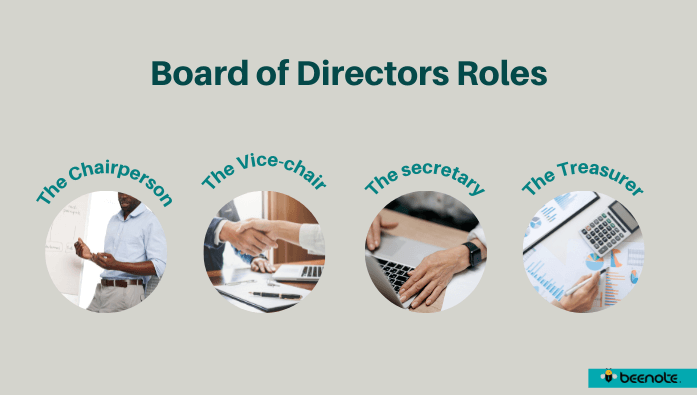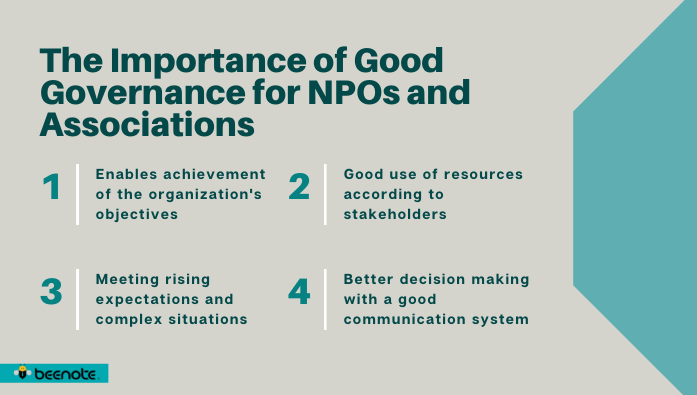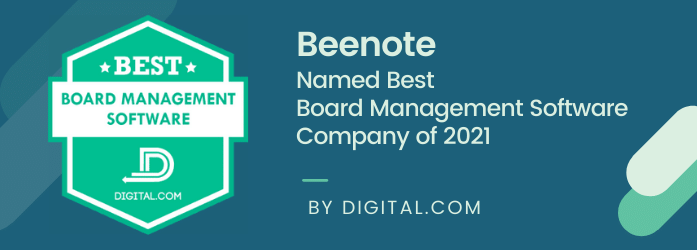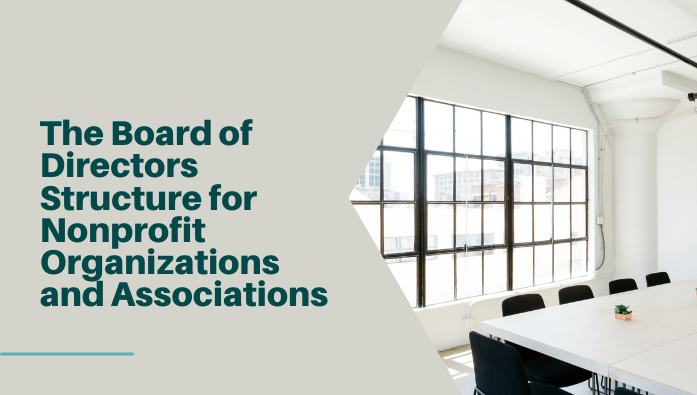Non-profit organizations and associations are an integral part of our community and all have different missions in different sectors and domains. One thing they all have in common is a board of directors structure supported by strong governance.
These organizations depend on stakeholders such as donors and government, recruitment of qualified staff, and most importantly, a resilient board of directors. Having a system to properly regroup and communicate is more than crucial!
In this article, we are interested in how associations and NPOs must successfully govern themselves within their board of directors. Of course, you will also find our tips and tools for maintaining good governance.
Here’s what we’ll cover:
- The Board of Directors structure for NPOs and associations
- The selection of board members
- The roles and responsibilities of the Board
- The different committees
- Meetings of the Board of Directors
- What is governance for NPOs and associations?
- Why is it important to maintain good governance?
- Our tips for maintaining good governance
- Use resources and take action
- Conclusion: the success of NPOs and associations

The Board of Directors Structure for NPOs and Associations
The Board of Directors relies on a highly structured system with rules of good conduct governed by codes of ethics, policies, procedures, and compliance. The Board serves as a gathering of all elected members to make decisions for the well-being and prosperity of the organization.
Let’s have a look at the outline of this structure!
-The Selection of Board Members
The first step is to establish the desired criteria to properly elect board members who can stand out and show determination.
A nomination committee is then created with members of management to select candidates. The selection process is based on standards and required competencies. For an association or non-profit organization, candidates must demonstrate dedication to the organization’s mission.
Finally, the selected candidates may be elected to the Board of Directors by the voting members at the annual meeting.
-The Roles and Responsibilities of the Board
A board of directors is used to bring together all elected members to discuss strategies and decisions. All members are equal, meaning they have the same power on the board, but some have distinct roles and responsibilities.

The Role of the Chairperson
The Chairperson or Board Leader serves as a point of contact with the Executive Committee and as a reference for any issues within the Board. The person is responsible for maintaining meetings, ensuring that objectives are met and that protocols are followed. He is also the leader of the meetings to ensure that they run smoothly and that the time allotted is respected.
The Role of Vice-Chair
The role of the vice-chair is to be the acolyte and backup to the chairperson in case of absence. The person in this role should aspire to take on the role of future Board Chair and serve as a reference for knowledge transfer.
The Role of Secretary
The Secretary is responsible for the organization of board meetings, including planning, writing the agenda, taking notes at the meeting, sharing the minutes, and following up on tasks with members. This administrative task is at the heart of a productive board.

The Role of Treasurer
The Treasurer is responsible for the financial aspects of the Board of Directors and works closely with the organization’s finance department.
-The Different Committees
Communication between the board, the executive committee, and the stakeholders (donors, government, etc.) is essential. We know that the Board of Directors is meant to bring all members together to decide on the direction of the organization, but several types of committees coexist around this system.

The executive committee is made up of several members of the executive board. They meet to redistribute the decisions of the Board of Directors to their teams and departments. Not all associations and organizations need an executive committee, as it can sometimes dilute information or, on the contrary, be very relevant in some cases.
Board committees can be divided into several groups, for example, the audit committee, the human resources committee, or sometimes the external affairs committee, and the internal affairs committee. Of course, the ethics and governance committee, which serves to establish a good governance system for the board, is an important element that we will discuss shortly.
-Meetings of the Board of Directors
There are many types of meetings, even within boards of directors. Directors may meet as often as necessary, but at least four times a year. The board must also meet once a year, which is called an annual general meeting. The purpose of this meeting is to elect board members and to conduct an annual review of the organization.
The conduct of a board meeting is as structured as these foundations. A pre-determined agenda must be followed during the meeting where information is conveyed and decisions are discussed. Then, a signed minute is shared with the entire board, and the responsible persons must also follow up on the operations.
What is Governance for NPOs and Associations?
Rule of thumb! An effective board of directors does not come without the adoption of good governance!
First of all, what is governance? It is defined as a set of policies, procedures, and practices for achieving common goals within an organization while adhering to standards of ethics, integrity, efficiency, and accountability.
In short, it is the rules for the proper functioning of a board of directors, i.e. the guidelines for good governance
In other words:

Once it has been established how the members will govern themselves, it is necessary to know how to maintain this governance over time.
Why is it Important to Maintain Good Governance?
As we already know, all board members need to meet and communicate together. However, without good governance, meetings can go back and forth. A good governance system helps the association or NPOs focus on the activities that contribute most to its overall goals, use its resources effectively and ensure that it is managed for the benefit of its stakeholders.
In addition, associations and NPOs must be well managed but also perceived as well administered, as they often depend on external resources.
All of them must face obstacles to meet the ever-increasing expectations of their stakeholders and evolve in an ever more complex operational context, as some have experienced in recent years with the pandemic. This suggests that the organization and association must be proactive and resilient to all eventualities.
In summary, good governance is about better communication and collaboration to make better decisions for the benefit of the organization.

Our Tips for Maintaining Good Governance
Each association or organization has its particularities, which means that the functioning of its board of directors may differ. However, they all need to maintain impeccable governance to get the most out of their meetings.
Here are our 9 tips of good conduct and practices that can help you maintain a good governance culture:
- Respect the code of governance and make documents available in a secure location to all members, such as a directory of minutes and a library
- Cultivate the importance of good organization by scheduling meetings well in advance
- Plan your meetings properly with the video conference link, an adequate agenda, and accessible to all before and during the meeting
- Remember to time the meeting to respect the planned schedule
- Use a tool where notes are taken in real-time within the agenda in order to save time when writing the minutes
- Maintain good communication and collaboration throughout your meeting, whether remote or face-to-face
- Share the official minutes with all board members and avoid paper by using electronic signatures
- Follow up rigorously and methodically so that tasks and decisions are clearly communicated to the right people and easily tracked
- Simplify and centralize your entire meeting process to fully optimize your governance

Use Ressources and Take Action
It’s good to want to maintain good governance, but you still need to have the right resources that will allow you to take concrete actions for this maintenance. There are several tools at your disposal, including meeting management solutions. This tool simplifies and centralizes the entire process of your board meetings. It allows you to:
- Save a lot of time in administrative tasks and document research
- Increase collaboration and facilitate communication with members or your entire organization
- Make better decisions by focusing on the essentials
- Better maintain your governance through structured and efficient meetings
There are many advantages to using a tool like Beenote which offers you Beeboard, its most complete solution for Boards in an easy to use and secure environment. Several exclusive features are highly relevant to maintaining your governance.
With Beenote, all your meeting content is in one place without preventing you from using your corporate tools such as Google, Microsoft, and Teams.
We Have Ressources to Guide you:
- Our article on how to choose a meeting management tool.
- Our agenda templates for board of directors and even executive committee.
- Our blog with a wide range of articles to help you optimize your meetings.
- Our meeting calculator, useful when implementing your tool.
- Our Beenote Academy page, where you can explore Beenote in detail with our functions and videos.

Conclusion: The Success of NPOs and Associations
We can conclude that the heart of your board is in good governance, and therefore in the quality of your meeting management process. Without effective meetings in your organization, it is like trying to breathe with weakened lungs. Success for associations and NPOs lies in the art of good meetings.
Don’t hesitate to give a free trial of our Beeboard tool that can support your governance and save you a lot of time to focus on your mission!
A passionate web content creator and writer at Beenote, her primary motivation is to create content that can guide organizations looking to optimize their meetings and boards. Giving practical resources to inspire businesses to adopt best practices to become meeting pros. No more wasting time!









0 Comments